Baby Tooth Chart – Timelines & All you need to know
Medically Reviewed by: Dr. Kedar Patnekar (MBBS, D.N.B, D.C.H, Specialist Pediatrician) Dubai, UAE.
-
Author: Amar Kirale
- >> Post Created: May 29, 2022
- >> Last Updated: April 23, 2024
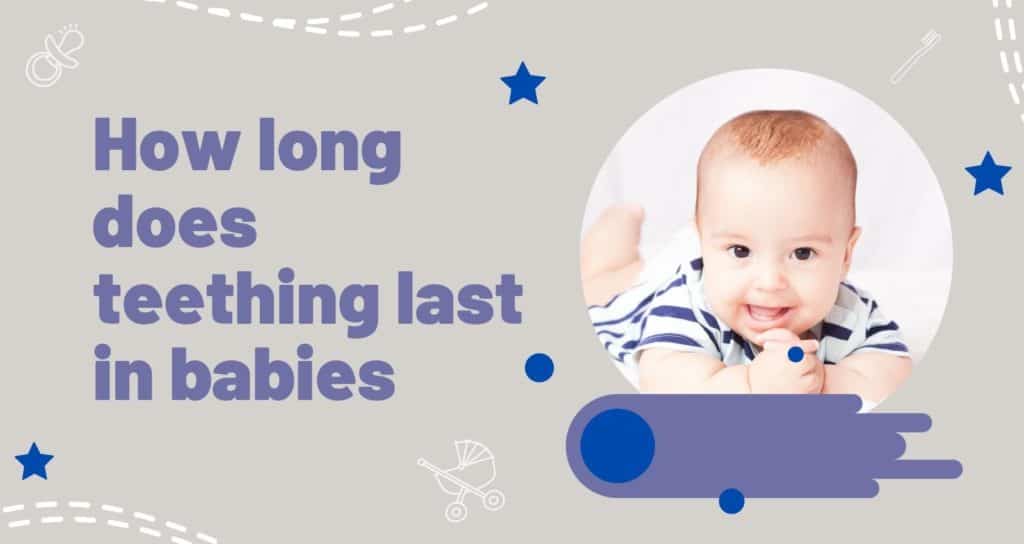
How long does teething last in babies - Table of Contents
Teething is one of the important, but painful, milestones in your baby’s life. Understanding the teething process and how to tackle the issues that come along with it is the only way to make the teething process easier for your little one and YOU!
We understand what discomfort, crankiness, and pain your baby must be going through during every single tooth eruption, and we bet it will make you wonder “how long does teething last?” I went through the same dilemma with my 4 kids!!
Through this article we intend to provide you a with a complete understanding about not only ‘how long does teething last for your baby,’ but also give you an overview of the teething timeline, signs of teething, how to manage a teething baby, and more….
To start with let’s understand a few symptoms of teething in babies.
Signs and Symptoms of teething in babies - Teething Symptoms
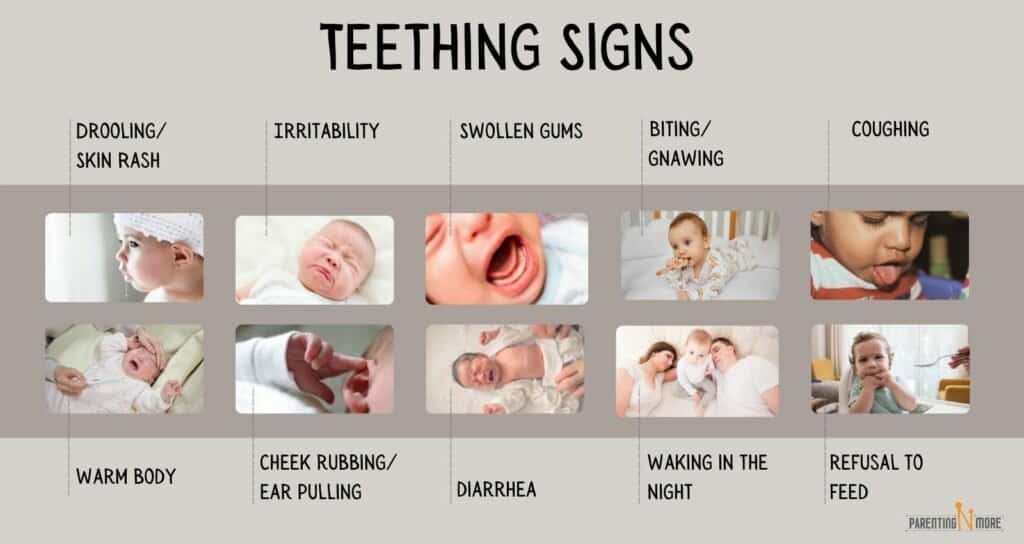
Teething in babies can start as early as during the first 4-5 months for a few babies. But like many other things, some kids can be faster… Teething can begin early in a few kids.
Before we go on to understand – ‘how long does teething last in babies?’ — let’s first understand what are the symptoms of teething in babies so that you can differentiate between any other ailments that could occur during the same time.
Common teething symptoms include the following –
- Drooling/Skin rashes: Teething stimulates the saliva glands, which results in excessive saliva, and hence, drooling. Babies do not develop the ability to swallow excessive saliva in the first year.
The drool on the baby’s skin in turn gives rise to skin rashes, also called as teething rashes.
You cannot control the drool, but you can certainly do a lot to keep your baby’s drool away from the skin. Use a well-absorbent bib, change wet clothes immediately, and keep the baby clean and dry (there are several methods to do this).
- Irritability: The irritability is understandable, especially in babies; in fact, the first set of teeth and molars cause the most discomfort and irritability. You will see they will cry and be more irritable than usual.
Believe it or not, but cuddling can really help calm your baby down when they are irritable due to teething.
- Swollen Gums: Teeth actually tear the gums out when they emerge. This causes tenderness in gums and you may feel that the gums of your child are more swollen than normal.
Swollen gums are an indication that the tooth is about to erupt. You will feel a little bit of the tooth’s edge and also feel the swollen gums of your baby.
- Biting/Gnawing: This comes naturally to babies – the counter pressure from biting eases the pressure the baby experiences from under the gums when a tooth eruption is expected.
Give your baby something clean and cold to gnaw on for comfort during teething. There are teething rings, chew beads, and many other teething toys available in the market for this purpose; you can chill them in the refrigerator and then give it to your baby. Please avoid teething gels as far as possible or else please consult your pediatrician before using it.
You may even give chilled food pouches for this. Ensure that the object is not too cold, you do not want your baby catching a cold.
- Coughing: The excessive saliva produced during teething can cause some coughing or a gag, as the baby still has to learn to swallow it properly.
Occasional coughing is fine, but if your baby’s cough is continuous and accompanied by a cold and/or fever, then it isn’t a teething symptom. See a doctor immediately.
- Warm body/low-grade fever: A warmer-than-usual body or a low-grade fever ranges from 98 to 100 degrees. It is not directly related to teething, as the probable cause of this can be the infant putting unclean objects or hands in the mouth during teething. So it is indirectly related to teething. However, if your baby shows a temperature of over 101, see a doctor immediately, as this is not due to teething.
Ensure the objects that your baby puts in the mouth are clean, and the surroundings are clean as well.
- Cheek rubbing & ear pulling: The pain caused by teething, especially when it is time for molars to erupt, travels to the cheek and ear. And this pain makes the baby rub their cheeks and ears to try to relieve the pain. However, if the ear rubbing and pulling persists or is accompanied with fever, then it could be a possible ear infection; see a doctor immediately.
You can gently massage the baby’s gums with clean fingers to ease the pain.
- Diarrhea: It is a possibility that the excessive saliva production during teething can cause slightly loose stools. Also putting unwanted things in the mouth can be one more reason for loose stools.
Further you may observe diaper rashes on their tushy due to these irregular bowel movements. Don’t worry, these rashes can be taken care of with some simple home remedies.
However, if the stool is watery and accompanied by fever and/or vomiting, then rush to the doctor, as your baby is at a risk of dehydration.
Even for slight diarrhea, refer to your pediatrician for the right medications.
- Waking in the Night: Teething causes uneasiness and discomfort to the baby, which could lead to disrupted sleeping.
- Refusal to Feed: You may notice that your child has reduced the number of feeds; however, they could show a sign of chewing onto something on and off, but due to irritation may not chew more.
However, it is known that feeding could soothe a cranky baby.
Read this next
When does the first baby tooth emerge and how long does teething last in babies?
Before we understand when baby’s first tooth emerge, or how long does teething last in babies, lets first understand a few concepts. In medical terms, teething is called ‘Odontiasis’ and is described as ‘the process by which an infant’s teeth erupt or break through the gums.’ The good news is that all teeth do not erupt at the same time.
By the time the baby is 25-33 months old, they develop 20 teeth, which usually start appearing when the baby is 6-10 months of age. For some babies, teething might begin as soon as the baby is 4 months old. Permanent set of first molars pop up at 6-7 years of age, while the second set arrive at 12-13 years. Of course, as kids grow, the issues associated with teething go down.
Teething symptoms start occurring about 4 days before a set of teeth actually erupt and the discomfort stays for approximately the next 3 days. Therefore, the actual teething pain lasts for about 7-8 days for each tooth eruption.
Do understand that if the baby continues to suffer from a certain issue for a longer time, then it may not be related to teething and get it checked by your doctor.
Your baby’s teeth usually pop out in pairs, generally in the following order –
- Lower central incisors (at around 6 months)
- Upper central incisors (at 8 months)
- Upper lateral incisors (at 10 months)
- Lower lateral incisors (at 10 months)
- Upper first molars (14 months)
- Lower first molars (14 months)
- Upper canines (18 months)
- Lower canines (18 months)
- Lower second molars (between 20 and 30 months)
- Upper second molars (between 20 and 30 months)
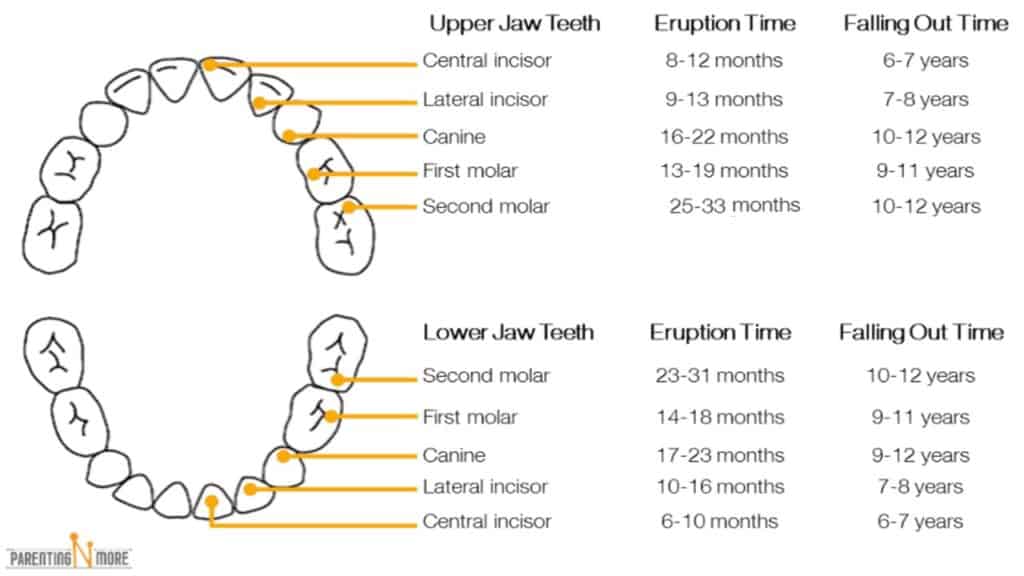
Early and delayed teething in babies
While understanding – ‘how long does teething last in babies’, you should also note that few kids teeth exceptionally early and few very late.
My daughter and trio goth their first tooth very late. Almost after a year.
While we have mentioned the appropriate age for teething, these time frames are general cases, but as stated there can be exceptions too. While some babies may start teething as young as when they are 3-4 months old, some may not begin till they are about 15 months old! Sometimes late teething can be hereditary.
The American Academy of Pediatrics (AAP) is of the opinion that a baby should have the first dental visit around the time the first tooth erupts or by the time they turn 1 year old, whichever arrives first.
Understanding the teething timeframe for babies
This is yet another thing you need to understand while learning -‘how long does teething last in babies’. It will help you if you know how to improve your responsiveness to your baby’s teething symptoms. The tooth chart below will give you a clearer picture of the various timeframes. So while you are already aware about the various signs of teething detailed above, these timeframes will help you further understand the general timeframes tooth eruption happens in babies.
Between 4-7 months approx.
Generally, it is in this span that the teething process begins. The first ones to arrive in this time are the two middle teeth in the lower jaw, called lower central incisors. Once they pop out, they add the cuteness to your baby’s grin.
However, as your baby starts moving around more on its own during this time and is exploring the surroundings, it is necessary that they do not put any random objects in their mouth during teething. This can easily cause stomach issues as the objects may have germs on it.
Between 8-16 months
In this second round of teething, the baby’s upper front teeth show up – the upper central incisors. In the same span of time, their upper and lower lateral incisors or the teeth next to the central incisors on both the upper and lower jaws will also make their way out.
This is the age when the baby is not only developing more teeth, but also skills like sitting up, standing without support, taking their first steps, picking and throwing objects, etc. Certainly an exciting time for a parent!
Between 13-23 months
Molars – which help chew solid food – make an entry on the top and bottom jaws between 13 and 19 months of age. Then by approximately 23 months of age the sharp and pointed canine teeth emerge on the top and bottom.
Between 23-33 months
This is the final teething stage, where the second set of molars or the teeth at the very end of the mouth appear on the lower jaw. The good news here is that the issues related to teething are lower and are easier to recognize as most children are able to communicate about the exact discomfort they are experiencing by this age.
Eruption of the second set of molars may bring headaches and jaw pain in toddlers.
Baby Tooth chart - Baby teething chart at a glance
Place of appearance | Type of tooth | Approx. age of appearance: bottom | Approx. age of appearance: top |
Front | First incisor | 5-10 months | 6-12 months |
Either side of front | Second incisor | 9-16 months | 9-13 months |
Pointy teeth at either side of the mouth | Canine | 17-23 months | 16-22 months |
Towards the back of the mouth | First molar | 12-16 months | 13-19 months |
At the back | Second molar | 20-31 months | 25-33 months |
Teething Treatments – How to manage baby teething?
Now while you are pro at understanding teething symptoms of your child and from above you have understood – how long would teething last – we now come to what is it that you can do to help your child deal with teething.
As parents, you can do plenty to help your baby overcome the tough teething phase. Some solutions are specific to certain teething symptoms, while some can help in overall discomfort.
1. Getting the baby something to bite/gnaw on
The pressure that the baby feels on the gums before a tooth is ready to erupt can be countered with external pressure that comes when the baby bites on something hard and firm. Of course, you have to ensure it is not a small object (to prevent any risk of choking) and clean.
These objects could be teething toys available in the market, a clean, wet, and cooled washcloth, rubber teething rings (avoid ones with gels or liquid within), etc.
2. Gum massage
Use your clean fingers to gently massage your baby’s gums to ease the aching gums during teething.
3. Keep the baby clean and dry
Drooling is one of the major teething symptoms, which in turn can give rise to painful skin rashes. To save your baby from the discomfort, ensure you use super absorbent bibs, change soiled and wet clothes immediately, and use powders, ointments, etc. to keep the skin dry.
4. Talk to your pediatrician
For some babies, teething can be more painful than usual and the parents might have to resort to over-the-counter or prescribed medicines. Your pediatrician may recommend Acetaminophen or Ibuprofen.
Note that these kinds of medications cannot be given to babies below 6 months of age and can only be administered in the age-appropriate dosages.
5. Cuddle your baby
Small babies find great comfort in their parents’ touch and cuddles. If it is their first time teething, along with the above options, cuddle more with your baby to give them the sense of comfort and security.
Avoid These
- Topical teething gels: They often contain Benzocaine that can have harmful side effects
- Homeopathy medicines: May contain Belladonna, which can be harmful for babies.
- Teething jewelry: Teething bracelets, necklaces, etc. may contain small pieces that can prove to be a choking hazard for the baby. Teething necklaces can also be a strangulation hazard. Teething jewelry also carry the risk of mouth injuries if your baby bites on them vigorously or can be a place for bacteria to harbor.
If you have teething jewelry, then ensure that the baby uses clean jewelry and only under constant supervision.
However most authorities including the FDA does not advocate using any kind of teething jewelry
Some Important Teething FAQs
Q1) Do teething symptoms worsen at nights?
With fewer distractions at night, the baby may be bothered by teething symptoms even more.
So it isn’t that the teething symptoms worsen at nights, but the baby’s attention to it increases.
Q2) Do teething babies eat less?
It depends! In some babies, swollen gums may make eating difficult, while on the other hand, for some babies, eating more can help to deal with the pain in the gums.
However, if your baby hasn’t eaten much continuously for a few days at a stretch, see your pediatrician.
Q3) What is teething diarrhea? Do teething babies poop more?
Teething does not really cause diarrhea. The age when babies start teething usually coincides with the time when babies also start eating solid food. This major shift in diet causes the changes in the bay’s bowel movements.
Sometimes you can observe diaper rashes which arise due to these changes in the bowel movements. However, teething diaper rash is not a norm.
If the diarrhea condition persists for over 24 hours, make sure your baby stays hydrated and see your pediatrician.
Q4) Can a teething baby be breastfed?
For some teething babies, suckling may help with the discomfort, while for some, it may increase the pain.
If you are worried that the baby may bite you, try to massage the baby’s gums with clean fingers before breastfeeding and in case the baby bites, pulling away or saying ‘ouch’ may send the message across.
My babies responded to the ‘ouch’ well over a period of time.
Q5) Does teething cause fever?
No, teething should not cause fever. The reason why teething is wrongly accused of being the cause for fever is that it coincides with the time the baby starts consuming solid food (6 months of age), decreasing the intake of breast milk (which has antibodies), and therefore, is more prone to infections.
Therefore, fever during teething should not be ignored believing it to be a teething symptom and a doctor should be consulted immediately.
Q6) My baby’s gums are swollen. When will the tooth start to show?
If your baby’s gums are swollen, then understand a tooth is ready to erupt. Swollen gums may remain for about 4 days before the tooth pops out. However, if you are still worried, then consulting your pediatrician will be helpful.
Q7) My baby is biting and drooling, is it because of teething?
Merely biting and drooling may not necessarily mean your baby is teething. However, if there are other teething symptoms along with drooling and biting, then your baby is teething.
Q8) How long before a tooth erupts that the pain starts?
The entire teething process (for each tooth eruption) lasts about 8 days.
The pain and discomfort begins about 4 days before the tooth pops out and lasts for about 3 days after the tooth erupts, as the situation settles. If the pain continues even after 8 days, then there is a good chance that the baby is suffering from some other issue.
Q9) Should I brush my baby’s tooth/teeth?
Yes, why not! Even after the first tooth erupts, you can brush your baby’s tooth after meals and before bedtime. Though these aren’t the baby’s permanent teeth, but it will set a precedent for oral hygiene for life.
Q10) Should I visit the dentist with my baby?
It is recommended that you visit a dentist with your baby six months after the first set of teeth pop out. However, most parents schedule their kid’s first dental appointment after 2 years of age. However, by that age, the child begins devouring sweets and chocolates, so it is recommended that you do visit a good pediatric dentist to spot any early signs of cavities and ensure your child’s oral development is on track
Key Takeaway
One of the most searched questions every time your baby gets cranky because of teething is – how long does teething last in babies? It is certainly a difficult time for your baby and parents.
Understanding the process of teething, especially with a tooth chart, will help you to stay calm and help your baby through the painful process in a better manner.
Teething symptoms start showing about 4 days before the actual tooth erupts and it takes another 3-4 days for the pain and discomfort to completely settle.
So eruption of every set of teeth till the age of 2-3 years will put your child in small, temporary phases. When parents know how to help their child through this phase, the little one’s toothy smile at the end of it will bring out the parents’ smile too.
We suggest you inculcate good oral hygiene behavior in your kids from the very beginning; after all, there was a lot of pain behind the making of this smile, right?
Hope this article gives you a detailed understanding about – how long does teething last in babies. We have also provided detailed signs and tips to manage teething. Hope these help you ease your child’s discomfort. Do let us know if you have more tips on dealing with teething. We will be happy to publish.
Happy teething!




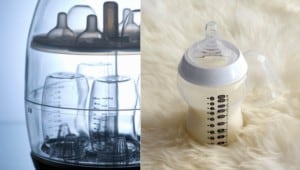
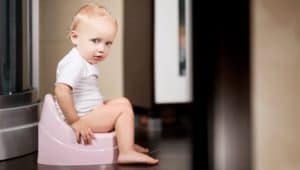
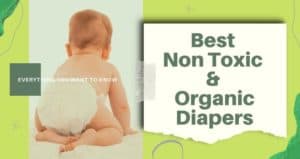



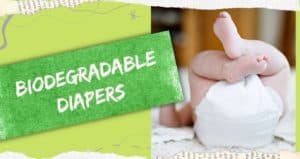


Thank you for sharing superb information. Your website is so cool I’m impressed by the details that you¦ve on this web site.
Bookmarked this web page, will come back for extra articles.
Hi, your article is really good. The clarity is simply nice and that I assume you are an expert on the subject of parenting.
Thanks a million and please continue the enjoyable work.
Thanks Katty for the encouraging words.
Very interesting information! Perfect just what I was looking for!
Thanks Evie for visiting our blog.
I am glad you found what you were looking for.